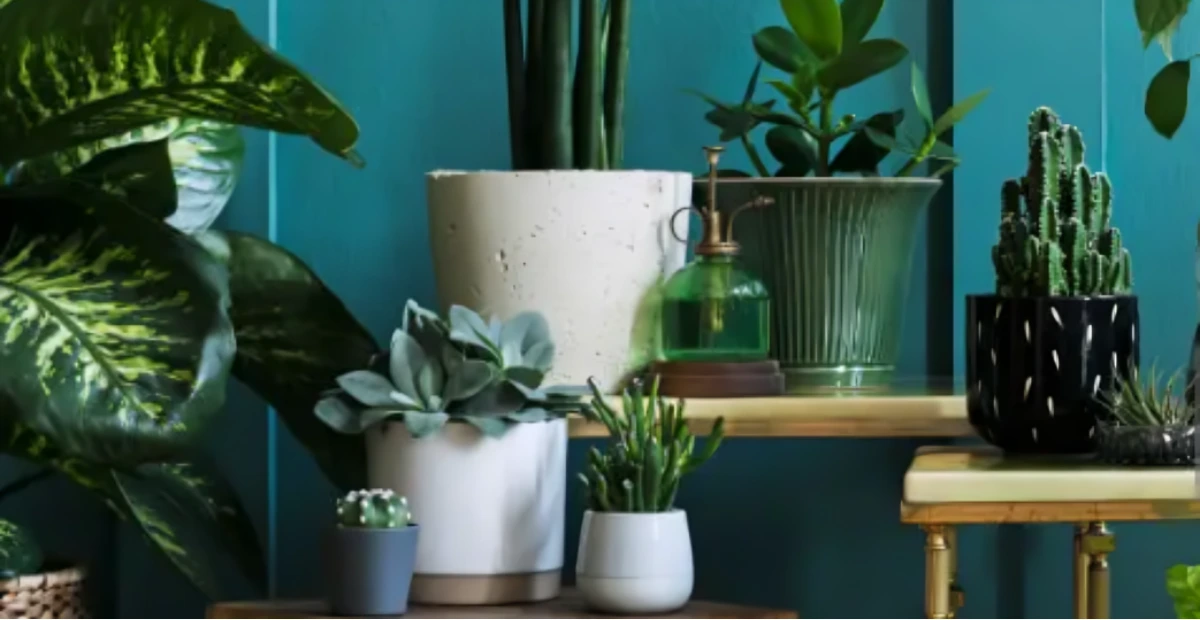Imagine walking into your living room after a long day—there’s a feeling of calm, freshness, and warmth that instantly lifts your spirits. It’s not just the comfy couch or the soft lighting; it’s the lush greenery of living room plants. These little touches of nature bring life and vibrancy to your home, transforming it into a welcoming haven. Whether you’re looking to improve your home’s aesthetic, boost your mood, or purify the air, adding plants is a simple and effective solution.
advertisement
In this guide, we’ll explore how living room plants can elevate your space. From choosing the right plants to styling them for maximum impact, you’ll learn everything you need to make your living room feel more inviting. So, if you’re ready to breathe new life into your home, let’s dive into the wonderful world of living room plants.
Table of Contents
Why Living Room Plants Are Essential for Your Home
The Power of Greenery: Why Plants Make Your Space Feel Inviting
When you think about plants in your living room, you might first envision a pop of color or a way to make your space feel more lively. But the benefits of plants go far beyond their appearance. Research shows that having greenery indoors can improve both your physical and mental well-being. Here’s how:
advertisement
- Emotional Impact: Plants have been proven to reduce stress and improve mood. They create a calming atmosphere that helps you unwind after a busy day. The presence of nature indoors makes people feel more comfortable and relaxed.
- Health Benefits: Did you know that plants improve air quality? Many indoor plants can help purify the air by absorbing toxins and releasing oxygen. This can help reduce pollutants and allergens in your home, promoting better overall health.
- Visual Appeal: Living room plants add color, texture, and depth to your décor. Whether it’s a bold fiddle leaf fig or a trailing pothos, plants serve as stunning focal points that enhance your room’s ambiance.
The Best Living Room Plants to Create an Inviting Space
Choosing the right plants for your living room can seem like a daunting task, especially with so many options available. But don’t worry! We’ve got you covered. The key is to select plants that complement your home’s lighting, size, and maintenance preferences.
Low-Maintenance Plants
If you’re new to indoor gardening or have a busy lifestyle, low-maintenance plants are a great option. They require minimal care but still make a huge impact.
- Snake Plant (Sansevieria): This plant is nearly indestructible. It thrives in low light and doesn’t require frequent watering. Plus, it’s an excellent air purifier.
- Pothos (Epipremnum aureum): A popular choice for beginners, pothos can grow in low to bright light and requires minimal watering. It’s also incredibly versatile, as you can place it in a hanging basket or let it trail down from shelves.
- ZZ Plant (Zamioculcas zamiifolia): The ZZ plant is a hardy, low-light lover that doesn’t mind dry soil. It can thrive on neglect, making it ideal for those with a busy schedule.
advertisement
Statement Plants
If you want to make a bold statement in your living room, larger plants can serve as dramatic focal points. They can completely transform the atmosphere of a room.
- Fiddle Leaf Fig (Ficus lyrata): Known for its large, glossy leaves, the fiddle leaf fig adds instant sophistication to any space. It prefers bright, indirect light and occasional watering.
- Monstera (Monstera deliciosa): The monstera’s iconic split leaves make it a striking addition to any room. It thrives in indirect light and needs moderate watering.
- Rubber Tree (Ficus elastica): With its thick, shiny leaves, the rubber tree brings elegance to your living room. It grows well in moderate light and needs regular watering.
Air-Purifying Plants
For a healthier living room, consider adding air-purifying plants that help filter toxins from the air.
- Peace Lily (Spathiphyllum): Peace lilies are not only beautiful with their white blooms, but they also excel at removing indoor pollutants. They thrive in low to moderate light and require weekly watering.
- Spider Plant (Chlorophytum comosum): The spider plant is a fast-growing, low-maintenance plant that can purify the air. It’s perfect for beginner plant owners.
- Bamboo Palm (Chamaedorea seifrizii): This elegant palm plant adds a touch of tropical charm to your living room while improving air quality.
Pet-Safe Plants
If you have furry friends at home, it’s essential to choose plants that are safe for pets. Fortunately, there are several beautiful and non-toxic plants to consider.
advertisement
- Spider Plant: A safe and easy-to-care-for plant that both pets and humans can enjoy.
- Calathea: Known for its stunning patterned leaves, the calathea is a pet-safe plant that adds a touch of elegance to your space.
- Parlor Palm (Chamaedorea elegans): This graceful plant is non-toxic to pets and thrives in low to moderate light.
Styling Living Room Plants: How to Display Them for Maximum Impact
Now that you know which plants to choose, the next step is to figure out how to display them in your living room. Proper placement is key to ensuring your plants thrive and contribute to your space’s overall appeal.
Where to Place Living Room Plants for Best Effect
The right placement can make all the difference in how your plants enhance your living room. Consider the following tips to position them strategically:
Focal Points
Place your plants in areas that naturally draw the eye, such as corners or near furniture. A tall plant like a fiddle leaf fig can instantly become a striking focal point when placed in the corner of a room. Larger plants work well in open spaces, where they can command attention.
Shelves & Tables
Smaller plants look great on bookshelves, coffee tables, or side tables. These plants add a touch of greenery without overwhelming the space. Use a variety of plant sizes for visual interest—grouping several small plants together can create a beautiful and balanced look.
advertisement
Hanging & Wall-mounted Plants
If you’re short on space, hanging or wall-mounted planters are a great solution. Plants like pothos and ivy look stunning when allowed to cascade down from hanging baskets or wall-mounted shelves. This not only saves floor space but also adds a dynamic, layered effect to your décor.
Light Considerations
Each plant has unique light requirements, so make sure to place them where they’ll receive the right amount of sunlight. Some plants thrive in bright, indirect light, while others, like the snake plant, do well in low-light conditions. Pay attention to the lighting conditions in your living room and place your plants accordingly.
Caring for Living Room Plants: Keeping Them Healthy and Thriving
Once you’ve chosen and styled your living room plants, it’s time to take care of them. Here are the essential care tips you’ll need to keep your plants thriving.
Essential Plant Care Tips for Living Room Plants
Watering
One of the most common mistakes plant owners make is overwatering. While each plant has different watering needs, a general rule of thumb is to let the soil dry out between waterings. Stick your finger into the soil to check if it’s dry—if it is, it’s time to water.
advertisement
- Snake Plant: Water every 2-3 weeks, allowing the soil to dry out completely.
- Pothos: Water when the top inch of soil feels dry.
- Fiddle Leaf Fig: Water when the top 2-3 inches of soil are dry.
Light Needs
The amount of light your plant needs depends on its species. Some plants, like the snake plant and ZZ plant, can thrive in low light, while others, like the fiddle leaf fig and monstera, require bright, indirect light. Make sure to adjust your plant’s placement based on the amount of natural light it receives.
Pruning & Maintenance
Regular maintenance is essential to keeping your plants healthy. Prune dead or yellowing leaves to encourage new growth and prevent disease. You should also rotate your plants every few weeks to ensure even growth.
Fertilizing
Plants benefit from regular feeding, especially during the growing season (spring and summer). Use a balanced, water-soluble fertilizer to provide the nutrients your plants need. Be sure to follow the manufacturer’s instructions, as over-fertilizing can harm your plants.
Enhancing Your Living Room with Plant-Based Décor
Plants can do more than just add greenery to your space—they can also serve as decorative accents. Here are some ideas to incorporate plants into your living room décor:
DIY Ideas to Decorate with Living Room Plants
- Create a Plant Corner: Dedicate a corner of your living room to plants for a natural, calming vibe. Mix plants of different sizes and textures for visual variety.
- Use Stylish Planters: The right planter can make a huge difference in how your plants look. Choose planters that match your décor style—whether it’s modern, rustic, or boho.
- Mix with Other Natural Elements: Pair your plants with wooden furniture, woven baskets, or stone vases to enhance the natural vibe of your space.
advertisement
Conclusion: Transform Your Living Room with Greenery
Adding living room plants is one of the easiest and most effective ways to make your space feel more inviting. From choosing the right plants to styling and caring for them, the process is simple yet rewarding. Whether you’re looking to improve your home’s décor, boost your mood, or purify the air, living room plants are a perfect solution.
So, why wait? Bring nature indoors today and transform your living room into a beautiful, refreshing space that you and your guests will love. Start with a few low-maintenance plants or go bold with larger statement pieces—the possibilities are endless.
FAQ – Living Room Plants: How to Make Your Space Feel More Inviting
Q: What are the best plants for low-light living rooms?
A: Plants like the snake plant, pothos, and peace lily thrive in low-light conditions and can add greenery to dimly lit spaces.
Q: How can I make my living room look more inviting with plants?
A: Use plants in varying sizes and textures, group them together for a layered effect, and place them in stylish planters that match your décor style.
Q: How often should I water my living room plants?
A: Water your plants when the top inch or two of soil feels dry. Each plant species has different needs, so adjust accordingly.
Q: Can living room plants improve air quality?
A: Yes! Plants like peace lilies and spider plants help filter out toxins from the air, improving the overall air quality in your home.
Table: Quick Care Guide for Popular Living Room Plants
| Plant Type | Watering Frequency | Light Needs | Pet Safety |
|---|---|---|---|
| Snake Plant | Every 2-3 weeks | Low to moderate light | Safe |
| Pothos | Once a week | Low to bright indirect | Safe |
| Fiddle Leaf Fig | Every 7-10 days | Bright, indirect light | Toxic to pets |
| Peace Lily | Every 1-2 weeks | Moderate to bright light | Toxic to pets |
| Monstera | Once a week | Bright, indirect light | Safe |
advertisement
By following these tips and choosing the right plants for your living room, you can create a space that’s not only more inviting but also healthier and more stylish. So go ahead, bring a touch of nature into your home today!


